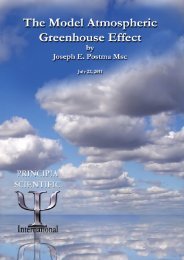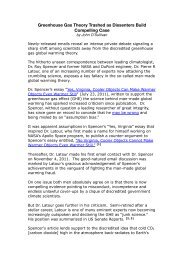Than 1000 International Scientists Dissent Over Man-Made Global ...
Than 1000 International Scientists Dissent Over Man-Made Global ...
Than 1000 International Scientists Dissent Over Man-Made Global ...
Create successful ePaper yourself
Turn your PDF publications into a flip-book with our unique Google optimized e-Paper software.
and, in the case of North America, left the Great Lakes in the glacier's retreat. The glaciers<br />
are still retreating, so there should not be any great surprise that the sea level is rising. The<br />
industrial revolution is about 150 years old, compared to 10,000 years of warming. Can<br />
human activities have really made a significant contribution to rising temperatures in that<br />
amount of time?‖ Farona asked. ―We know that the east coast of the U.S. was flooded<br />
during the previous interglacial period, so sea level rising and coastal flooding are not<br />
unique to this interglacial period. Why now the draconian predictions of coastal flooding as<br />
if this has not happened before?‖ he continued. ―What is the relationship between an<br />
increased level of carbon dioxide and temperature? Can it be predicted that an increase of<br />
so many parts per billion of carbon dioxide will cause an increase of so many degrees? I<br />
have not seen any answers to the questions posed above, leading me to adopt a somewhat<br />
skeptical view of blaming global warming on human activities. What puzzles me is the<br />
reluctance of climatologists to provide scientific data supporting their dire predictions of<br />
the near future if we don't change our ways,‖ Farona concluded. (LINK) & (LINK)<br />
Climate statistician Dr. William M. Briggs, who specializes in the statistics of forecast<br />
evaluation, serves on the American Meteorological Society's Probability and Statistics<br />
Committee and is an Associate Editor of Monthly Weather Review. Briggs, a visiting<br />
Mathematics professor at Central Michigan University and a Biostatistician at New<br />
York Methodist Hospital, has a new paper coming out in the peer-reviewed Journal of<br />
Climate which finds that hurricanes have not increased in number or intensity in the<br />
North Atlantic. Briggs, who has authored numerous articles in meteorological and<br />
climatological journals, has also authored another study looking at tropical cyclones around<br />
the globe, and finds that they have not increased in number or intensity either. Briggs<br />
expressed skepticism about man-made global warming fears in 2007. "There is a lot of<br />
uncertainly among scientists about what's going on with the climate," Briggs wrote to EPW<br />
on December 28, 2007. "Most scientists just don't want the publicity one way or another.<br />
Generally, publicity is not good for one's academic career. Only, after reading [UN IPCC<br />
chairman] Pachauri's asinine comment [comparing scientists skeptical of man-made<br />
climate fears to] Flat Earthers, it's hard to remain quiet," Briggs explained. "It is well<br />
known that weather forecasts, out to, say, four to five days, have skill; that is, they can beat<br />
just guessing the average. Forecasts with lead times greater than this have decreasing to no<br />
skill," Briggs wrote. "The skill of climate forecasts---global climate models---upon which<br />
the vast majority of global warming science is based are not well investigated, but what is<br />
known is that these models do not do a good job at reproducing past, known climates, nor<br />
at predicting future climates. The error associated with climate predictions is also much<br />
larger than that usually ascribed to them; meaning, of course, that people are far too sure of<br />
themselves and their models," he added. Briggs also further explained the inadequacies of<br />
climate models. "Here is a simplified version of what happens. A modeler starts with the<br />
hypothesis that CO2 traps heat, describes an equation for this, finds a numericalapproximate<br />
solution for this equation, codes the approximation, and then runs the model<br />
twice, once at ‗pre-industrial‘ levels of CO2, and once at twice that level, and, lo!, the<br />
modeler discovers that the later simulation gives a warmer atmosphere! He then publishes a<br />
paper which states something to the effect of, ‗Our new model shows that increasing CO2<br />
warms the air,‘‖ Briggs explained. ―Well, it couldn't do anything *but* show that, since<br />
that is what it was programmed to show. But, somehow, the fact the model shows just<br />
what it was programmed to show is used as evidence that the assumptions underlying the<br />
84





